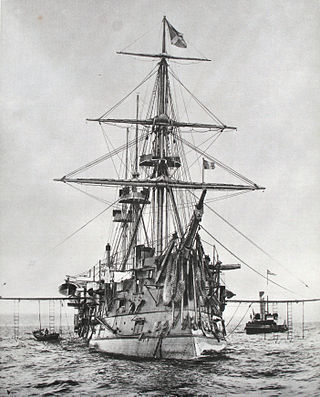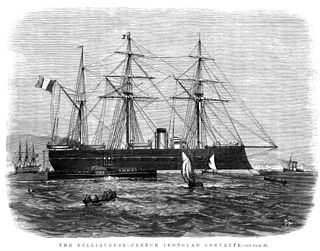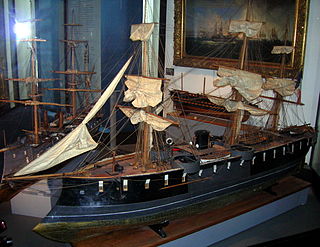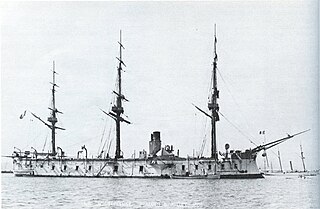
The French ironclad Colbert was the lead ship of the Colbert-class ironclads that were built for the French Navy in the 1870s. The ship was the flagship of the Mediterranean Squadron for most of her career. She took part in the French conquest of Tunisia, notably shelling and landing troops in Sfax on 15–16 July 1881. Colbert was paid off in 1895 and condemned in 1900. The ship was finally sold for scrap in 1909.

The French ironclad Richelieu was a wooden-hulled central battery ironclad built for the French Navy in the early 1870s. She was named after the 17th century statesman Cardinal de Richelieu. The ship was the flagship of the Mediterranean Squadron for most of her career. Richelieu caught on fire in Toulon in 1880 and was scuttled to prevent her magazines from exploding. She was salvaged and, after being repaired, resumed her role as flagship. In 1886, however, the ship was placed in reserve and was eventually condemned in 1901. While being towed to the ship breakers in Amsterdam in 1911, Richelieu was caught in a storm in the Bay of Biscay and had to be cast loose from her tugboat. Nevertheless, the ship survived the storm and was recovered near the Scilly Isles from where she was towed to her final destination.

The Colbert class were a pair of armored frigates built for the French Navy during the 1870s. The ships served as the flagships of the commander and deputy commander of the Mediterranean Squadron for most of their careers. The sister ships took part in the French conquest of Tunisia, notably shelling and landing troops in Sfax in 1881. They were relegated to second-line roles in 1894–95 before being condemned in 1900. The ships were finally sold for scrap in 1909.

Jeanne d'Arc was a wooden-hulled armored corvette built for the French Navy in the late 1860s. She was named for Joan of Arc, a Roman Catholic saint and heroine of the Hundred Years War. Jeanne d'Arc participated in the Franco-Prussian War of 1870–1871 and remained in commission afterwards, unlike many of her sisters. The ship was condemned in 1883, but nothing further is known as to her disposition.

Océan was a wooden-hulled, armored frigate built for the French Navy in the mid to late 1860s and the lead ship of her class. She was commissioned in 1870 to participate in the Franco-Prussian War and was assigned to the Baltic Squadron that unsuccessfully attempted to blockade Prussian ports in the Baltic Sea. The ship later served in both the Northern and Mediterranean Squadrons before being discarded in 1894.

The French ironclad Trident was the second and last ship of the Colbert-class ironclads that were built for the French Navy in the 1870s. The ship was the flagship of the deputy commander of the Mediterranean Squadron for most of her career. She took part in the French occupation of Tunisia, notably shelling and landing troops in Sfax in 1881. Trident was reclassified as a training ship in 1894 and condemned in 1900, before she was finally sold for scrap in 1909.

The French ironclad Belliqueuse was a wooden-hulled, armored corvette, built for the French Navy in the 1860s and designed as a cheap ironclad. She was the first French ironclad to sail around the world, which she did between December 1867 and May 1869. She spent the bulk of her career in the Pacific before returning to Toulon, where she was used as a target in 1886.

The French ironclad Armide was a wooden-hulled armored corvette built for the French Navy in the mid-1860s. Placed into reserve after completion, she was first mobilized for the Franco-Prussian War of 1870–1871. She spent the rest of her career in the Mediterranean and then in the Far East as flagship of the French squadrons there, until her decommissioning in 1880. Armide was use as a target for gunnery trials in 1886.

The French ironclad Atalante was a wooden-hulled armored corvette built for the French Navy in the mid-1860s. She played a minor role in the Franco-Prussian War of 1870, bombarded Vietnamese forts during the Battle of Thuận An in 1884 and participated in the Sino-French War of 1884–1885. Atalante was reduced to reserve in Saigon, French Indochina, in 1885 and sank there two years later after having been condemned.

The French ironclad Montcalm was a wooden-hulled armored corvette built for the French Navy in the mid-1860s. She was named after Major General Montcalm who lost the Battle of the Plains of Abraham in 1759. She played a minor role in the Franco-Prussian War of 1870–1871 where she captured one Prussian sailing ship. Montcalm spent most of her later career abroad, either in Chinese waters or in the Pacific Ocean. The ship was condemned in 1891.

The French ironclad Reine Blanche was a wooden-hulled armored corvette built for the French Navy in the late 1860s as an improvement over the armored corvette Belliqueuse. She played a minor role in the Franco-Prussian War of 1870–1871 and was accidentally rammed by one of her sister ships in 1877. The ship bombarded the port of Sfax during the French occupation of Tunisia in 1881 before being sent to the Pacific in 1884. She quickly returned to port with worn-out boilers and was condemned later that year.

The French ironclad Thétis was a wooden-hulled armored corvette built for the French Navy in the late 1860s. She was named for the Greek sea-goddess Thetis. During the Franco-Prussian War of 1870–1871 she was assigned to a squadron of French ships that attempted to blockade the Prussian ports in the Baltic Sea in 1870. She accidentally rammed her sister Reine Blanche in 1877. En route to the Pacific in 1884 her propeller fell off and she had to return to France under sail. Thétis was eventually hulked in New Caledonia.

The Alma-class ironclads were a group of seven wooden-hulled, armored corvettes built for the French Navy in the mid to late 1860s. Three of the ships attempted to blockade Prussian ports in the Baltic Sea in 1870 during the Franco-Prussian War. Three others patrolled the North Sea and the Atlantic, while the last ship was en route to Japan when the war began and blockaded two small Prussian ships in a Japanese harbor. Afterwards they alternated periods of reserve and active commissions, many of them abroad. Three of the ships participated in the French occupation of Tunisia in 1881 while another helped to intimidate the Vietnamese Government into accepting status as a French protectorate and played a small role in the Sino-French War of 1884–85.

The La Galissonnière-class ironclads were a group of wooden-hulled, armored corvettes built for the French Navy during the 1870s, meant as a heavier armed and faster version of the Alma-class ironclads. While all three ships were begun before the Franco-Prussian War of 1870–71, the construction of the last two ships was delayed for years. The navy took advantage of the extended construction time of the latter ships to upgrade their armament. La Galissonnière bombarded Sfax in 1881 as part of the French occupation of Tunisia. She and her half-sister Triomphante participated in a number of battles during the Sino-French War of 1884–85. Their sister Victorieuse had a much quieter career. All three ships were decommissioned in the 1890s.

The Océan-class ironclads were a class of three wooden-hulled armored frigates built for the French Navy in the mid to late 1860s. Océan attempted to blockade Prussian ports in the Baltic Sea in 1870 during the Franco-Prussian War and Marengo participated in the French conquest of Tunisia in 1881. Suffren was often used as the flagship for the Cherbourg Division, the Channel Division, Mediterranean Squadron and the Northern Squadron during her career. The ships were discarded during the 1890s.

Marengo was a wooden-hulled, armored frigate of the Océan class, built for the French Navy in the mid to late 1860s. The ship was running her sea trials in July 1870 when the Franco-Prussian War began and was immediately placed in reserve until after the war was over. Marengo participated in the French occupation of Tunisia in 1881 and was flagship of the Northern Squadron in 1891 when it made port visits in Britain and Russia. She was sold for scrap in 1896.

Suffren was a wooden-hulled, armored frigate of the Océan class, built for the French Navy in the mid to late 1860s. Although she was laid down in 1866, the ship was not launched until 1870 and commissioned in 1876. Suffren was one of the French ships assigned to the international squadron gathered to force the Ottoman Empire to carry out its obligations under the Treaty of Berlin in 1880. The ship was paid off in 1895 and discarded two years later.

La Galissonnière was lead ship of a class of wooden-hulled, armored corvettes built for the French Navy during the 1870s. She was named after the victor of the Battle of Minorca in 1756, Marquis de la Galissonnière. She bombarded Sfax in 1881 as part of the French occupation of Tunisia and was present in Alexandria shortly before the British bombarded it before the beginning of the 1882 Anglo-Egyptian War. The ship participated in a number of battles during the Sino-French War of 1884–85. La Galissonnière was condemned in 1894.

Victorieuse (Victorious) was the second ship of the La Galissonnière class of wooden-hulled, armored corvettes built for the French Navy during the 1870s. Her construction was delayed for years and the navy took advantage of the extended construction time to upgrade her armament in comparison to the lead ship, La Galissonnière. Unlike her sisters, Victorieuse did not see any combat although she participated in the pacification of the Marquesas Islands in 1880. She was condemned in 1900.

Triomphante (Triumphant) was the third and last ship of the La Galissonnière class of wooden-hulled, armored corvettes built for the French Navy during the 1870s. Her construction was delayed for years and the navy took advantage of the extended construction time to upgrade her armament in comparison to the lead ship, La Galissonnière. She and her half-sister La Galissonnière participated in a number of battles during the Sino-French War of 1884–85. The ship remained in Asia and never returned to France after the war. She was condemned in 1896 and sold in 1903.











